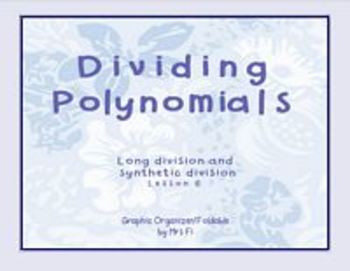Polynomials Lesson 6 Dividing with Long and Synthetic Division
Imagine You Love Algebra
211 Followers
Grade Levels
7th - 12th, Adult Education, Homeschool
Subjects
Resource Type
Standards
CCSSHSA-SSE.B.3a
CCSSHSA-APR.A.1
Formats Included
- PDF
Pages
8 pages
Imagine You Love Algebra
211 Followers
Description
The topics included in these notes are the following:
1. Division of Polynomials: each problem is completed using both methods
• Long division – it is suggested teaching long division should be done first, all problems are completed using long division and then to help you save on paper copies, you can use the half sheet to teach synthetic division for the very first time.
• Synthetic division – a half sheet is included to help you teach synthetic division, each student gets a half sheet before solving in the 4 part organizer.
2. Using the Remainder Theorem – 2 examples are used to illustrate the theorem.
This 4 part graphic organizer can be used as a review guide before a test or it could also be used instead of notes; students actually prefer this type of note taking format. I use an interactive notebook, and each graphic organizer can be placed in one page of the notebook.
Available Free Videos in Educreations using this product
Long Division Video
Polynomials Long Division
Synthetic Division Video
Polynomials Synthetic Division
I hope this organizer is helpful to you and your students; I would love to hear back from you and see how it helped you.
1. Division of Polynomials: each problem is completed using both methods
• Long division – it is suggested teaching long division should be done first, all problems are completed using long division and then to help you save on paper copies, you can use the half sheet to teach synthetic division for the very first time.
• Synthetic division – a half sheet is included to help you teach synthetic division, each student gets a half sheet before solving in the 4 part organizer.
2. Using the Remainder Theorem – 2 examples are used to illustrate the theorem.
This 4 part graphic organizer can be used as a review guide before a test or it could also be used instead of notes; students actually prefer this type of note taking format. I use an interactive notebook, and each graphic organizer can be placed in one page of the notebook.
Available Free Videos in Educreations using this product
Long Division Video
Polynomials Long Division
Synthetic Division Video
Polynomials Synthetic Division
I hope this organizer is helpful to you and your students; I would love to hear back from you and see how it helped you.
Total Pages
8 pages
Answer Key
Included
Teaching Duration
N/A
Report this resource to TPT
Reported resources will be reviewed by our team. Report this resource to let us know if this resource violates TPT’s content guidelines.
Standards
to see state-specific standards (only available in the US).
CCSSHSA-SSE.B.3a
Factor a quadratic expression to reveal the zeros of the function it defines.
CCSSHSA-APR.A.1
Understand that polynomials form a system analogous to the integers, namely, they are closed under the operations of addition, subtraction, and multiplication; add, subtract, and multiply polynomials.





